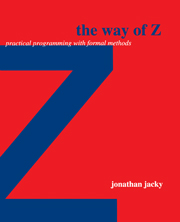Book contents
- Frontmatter
- Contents
- Preface
- I Why Z?
- II Introducing Z
- III Elements of Z
- IV Studies in Z
- V Programming with Z
- 26 Refinement
- 27 Program derivation and formal verification
- 28 From Z to code
- Further reading
- A Glossary of Z notation
- B Omitted features
- C Operator precedence
- D The Z mathematical tool-kit
- E Selected Laws
- F Solutions to selected exercises
- G Other formal notations
- Bibliography
- Index
28 - From Z to code
Published online by Cambridge University Press: 06 July 2010
- Frontmatter
- Contents
- Preface
- I Why Z?
- II Introducing Z
- III Elements of Z
- IV Studies in Z
- V Programming with Z
- 26 Refinement
- 27 Program derivation and formal verification
- 28 From Z to code
- Further reading
- A Glossary of Z notation
- B Omitted features
- C Operator precedence
- D The Z mathematical tool-kit
- E Selected Laws
- F Solutions to selected exercises
- G Other formal notations
- Bibliography
- Index
Summary
This chapter teaches a practical method for writing code from Z specifications that supplements intuition and experience with formal derivation.
The preceding Chapters 26 and 27 on refinement and program derivation show how to get from Z to code by purely formal methods, where each development step is a formula manipulation. As you must have realized, it is rarely necessary to develop an entire system in this completely formal way. The programming problems that arise within a single project usually present a range of difficulty. Large parts of the project may be so routine that there is no need for any formal description other than the code itself. Only a portion requires specification in Z. In this portion, you might refine only a fraction to a detailed design in Z. And in this fraction you might derive and verify only a page or two of code. The rest is so obvious that it can be translated to code by intuition and then verified by inspection.
Nevertheless, you can choose a strategy for implementing Z that you could justify formally by the methods of Chapters 26 and 27 if you were challenged to do so. This chapter presents such a strategy. When you have a formal specification, you can check designs and code rigorously if doubts remain after informal inspection.
The examples in this chapter are in C. They could easily be adapted to other programming languages.
- Type
- Chapter
- Information
- The Way of ZPractical Programming with Formal Methods, pp. 265 - 296Publisher: Cambridge University PressPrint publication year: 1996

